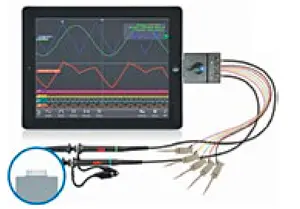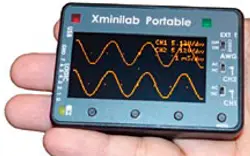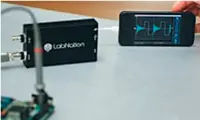
In this story, we explore the latest features and kinds of oscilloscopes that play an integral role in effectively testing designs today. We also learn how new technologies in oscilloscopes are enabling test and embedded engineers to design better.
As an engineer, if you want to improve your design overall, effective testing is an integral part. However, it means possessing tools you can rely on and that can provide consistent results as per requirements.
Today, oscilloscopes come in numerous shapes and sizes -from as small as a wristwatch to pocket-sized and bench-top ones. They even have diverse bandwidths - from the entry-level 50MHz to the massive 100GHz! Let us explore the new technologies, innovations and breakthroughs in the oscilloscopes domain that help our engineers design better.

Oscium’s iMSO-204 and iMSO-204L are mixed-signal oscilloscopes designed specifically for the iPhone, iPad and iPod.
Highlights: 2 analogue + 4 digital channels, 50MSPS sample rate, 5MHz bandwidth, 200ns/div-10s/div.
From analogue to digital
From simple signal capture to complex time-domain signal analysis, oscilloscopes come with salient and contrasting functionalities. Oscilloscope manufacturers have augmented the automated capabilities and portability factor so that designers can accomplish swiftly and get more authentic measurements for increased productivity.
The invention of cathode ray tubes (CRTs) in the late 19th century was an important milestone for the birth of analogue oscilloscopes, and has changed the way of waveform representation, believes Srinivasa Appalla, manager-product support & application, Rohde & Schwarz. However, he says, "The technological advancements in electronic designs have put new requirements on signal analysis which are not met by analogue scopes. Digital oscilloscopes, introduced in the 80s, are dominating the market now because of the ability of digital signal processing, and respective analysis and documentation."
Sumit Sharma, marketing man-ager-India, Good Will Instrument Co. Ltd. too believes, that with the rapid advancement of technology, the oscilloscope market has also been shifting from conventional analogue oscilloscopes towards digital storage oscilloscopes (DSOs). He says, "In contrast to analogue oscilloscopes, the major function of a DSO is to not only convert signals from analogue to digital but also store testing data, allow remote control and transmission of data through various interfaces." But, he also believes, "Despite the strengths of DSOs, analogue oscilloscopes still play an important role of providing realtime signals and waveform display."
Mixed-signal and mixed-domain
"As oscilloscopes have evolved from analogue to digital and from mixed-signal oscilloscopes to mixed-domain oscilloscopes, they have become even more valuable tools for analysing system performance or troubleshooting problems," says Pamela Aparo, marketing manager-electronic test & measurement, Analog Devices Inc.
Embedded system designers require advanced testing capabilities to resolve their design issues, so mixed-signal oscilloscopes (MSOs) emerged in the beginning of 2000, informs Sharma. He says, "There has been a growing need for detecting digital signals which are usually presented by two discrete voltage levels." A logic analyser, which is the best fit for such digital-signal measurements, has the benefit of multiple-channel input measurements, usually limited to two or four channels in oscilloscopes. He adds, "Nowadays, some system designers not only need an MSO but also an instrument which can afford to do frequency- and time-domain analysis simultaneously. So, a mixed-domain oscilloscope (MDO) is the latest trend."
The continuously-evolving integration level of embedded designs drives further feature integration into oscilloscopes. Appala says, "Additional digital channels, as part of mixed-signal options, protocol-specific trigger and decode options are a few examples. The key requirement is a synchronised operation of such features for true system-level debugging."
In the analogue to digital era, a significant number of digital designs came onto the analogue board, thus MSOs came to light about ten years ago. "The trend has evolved since, and mixed-domain oscilloscopes came into existence with Tektronix leading the charge. Today, mixed domain has moved to another level with the inclusion of wireless RF signals," says David Farrell, general manager-mainstream oscilloscopes, Tektronix. He adds, "Analogue, digital and now RF signals are coming together to the embedded domain and creating significant changes on how work is done in designs houses and research centres, specifically with respect to analysing those signals in as short a time as possible."
On a similar note, Aparo says, "Mixed-domain oscilloscopes offer similar benefits as mixed-signal oscilloscopes when an engineer needs to analyse signals in both the time domain and frequency domain - and these are useful in looking for problems that are caused by phase instability or phase offsets."
Not everyone is into MDOs though. On the contrary, Sanchit Bhatia, digital applications specialist, Agilent Technologies India believes, MDOs are an attempt to add spectrum analyser capability to oscilloscopes. He says, "MSOs have not evolved to MDOs as yet due to lower specifications. In fact, in MDOs, the oscilloscope and spectrum analyser capabilities have gone backwards. Any general oscilloscope and any entry-level spectrum analyser have better specifications than today's MDOs." Supporting his view, he adds, "A stand-alone spectrum analyser and a stand-alone oscilloscope are a better solution than an MDO, as they offer full instrument capabilities and can be synchronised using external trigger, if the application so demands."
Our fast-moving world needs to analyse data fast, and also on the move, informs Vivek Mantri, country manager-industrial segment, Scientech Technologies. He says, "Trending technology in telecom and RF segments needs data analysis to be extremely accurate in time to display waveforms, and in frequency to display signal spectra, where MDOs are a perfect choice." However, he adds, "For most of the general-purpose requirements, analogue oscilloscopes are sufficient."

Gabotronics’ Xminilab Portable is a small mixed-signal oscilloscope with an arbitrary waveform generator and protocol sniffer.
Highlights: 2 analogue inputs, maximum sampling rate of 2MSPS, 200kHz analogue bandwidth, 8-bit resolution, 1MQ 15pF input impedance, 256 buffer size per channel and input voltage range of -14V to +20V.
Are engineers ready to make the jump from knobs to a smartphone/tablet interface where they use their fingers to zoom in on a part of a waveform?
Handheld, PC-based, phone and even a wristwatch scope
Oscilloscopes have evolved from the typical bench-top instruments to as small as a wristwatch, providing flexibility and an array of choices. Mantri defines today's generation as tech-savy, that is more comfortable with touch screens and USB data transfers. He says, "They want their oscilloscopes to be handheld, with an easy interface, and prefer data transfers through SD cards. Different user segments will find analogue, MSO or PC-based instruments useful, depending on their usage." Although, he maintains, no single technology can be suitable for all kinds of applications.
Today's handheld oscilloscopes range from 20MHz to 500MHz in bandwidth, with sampling rates from 500Msa/s to 5GSa/s, and mostly come with LCD displays. Typically, with two channels, these are ideally suited for use by hobbyists, students, technicians and anyone else looking for an easy-to-use, affordable, single-channel PC oscilloscope.
PC-based oscilloscopes, complemented with software, provide bandwidth signal analysis anywhere between few tens of MHz to as high as 20GHz. These USB, modular devices typically have one, two, four or even eight channels with USB 2.0 or USB 3.0 interface, depending on the model. Some of them are even loaded with memory capacity. The software provided with these instruments is used to transfer instrument set ups, measurement data and images, and mostly favours the Windows operating system. But some oscilloscope makers are providing support for Linux, Mac OS X and even for Raspberry Pi.
Interestingly, apart from these, engineers can now perform analysis on their iPhones and on small devices such as a wristwatch scope (see the box titled 'Exciting innovations in the last one year.')
There are various other pocket-friendly oscilloscope devices available in the market for engineers. At the end of the day, it all depends on the engineer's preference, purpose and understanding of the devices' limitations. People will either love it or remain nonchalant with these innovations.

LabNation’s SmartScope is a 100MS/s open source oscilloscope for iPad, Android and PC. A must-have for every Arduino and Raspberry Pi developer.
Highlights: 2x100MS/s 45MHz oscilloscope, 50MS/s arbitrary waveform generator, digital logic analyser at 100MS/s, digital waveform generator at 100MS/s, 200 waveforms/second data updates.
Knobs vs smart touch
Today, smart touch interfaces can be used to define areas where you want the oscilloscope to trigger. These interfaces are fully configurable. Traditional analogue scopes were designed for operation using dedicated knobs and buttons. However, the latest digital scopes incorporate touch-screen displays, enabling new operating concepts and enhancing ease of use, informs Appal-la. He says, "As the model acceptance heavily depends on the user's taste and experience, it is advantageous if instruments support multiple ways of operation -dedicated knobs, USB keyboard/mouse and touch-screen interface. An intuitive operating interface helps users to navigate faster and reduces time in setting up, executing and documenting measurements."
Oscilloscope makers keep adding features to their instruments based on user demand for more signal analysis. "Good touch-screen implementations support drag-and-drop functionality for organising the display with multiple waveform diagrams and for selection of predefined operations. Other innovative user-interface concepts include colour-coding of buttons and knobs for guiding the user," adds Appalla. In future, more touch-screen functionality, which is popular in consumer devices, will follow.
Sharing her personal experience, Aparo notes, "Although knobs and buttons are somewhat comforting when I start working with a new oscilloscope, I have to say that moving away from traditional knobs has made it easier to automate certain tests, and it has made it possible to save common configurations. The learning curve for using a new oscilloscope with multiple menu levels is higher than when purely analogue oscilloscopes were the only option-but this is also because the new oscilloscopes can do so much more." She adds, "Obviously, having USB interfaces on oscilloscopes makes it easier to store test results and import them into other programs for writing reports or presentations."
Although oscilloscope screens are evolving to capacitive touch interfaces with multi-touch capabilities that provide zoom capability and analysis capability with great ease, Bhatia believes that common traditional knobs like channel scaling, offset and trigger modes, to name a few, are being retained as the engineers are used to operating scopes with these knobs.
As the touch has been successfully implemented in mobile systems, more electronic devices will feature this technology. Sharma says, "In this fashion, a traditional hand-held oscilloscope is being upgraded to the full touch-screen hand-held scope as a next-generation transition. This may minimise the gap between high-end and low-end scopes and bring the whole new experience of using oscilloscopes to engineers."

Gabotronics’ Oscilloscope Watch
Highlights: 2 analogue inputs, 4MSPS maximum sampling rate, 200kHz analogue bandwidth, 8-bit resolution.
Notable changes in oscilloscopes in last one year
From 50MHz to 100GHz
An apparent factor when choosing an oscilloscope is bandwidth. And, incidentally, the biggest impact on the price of a scope is its bandwidth and the number of analogue samples per second that it can read. For error-free results, most engineers know that the samples per second figure should be at least three to five times higher than the bandwidth. Engineers, typically, prefer entry-level and mid-level oscilloscopes.
But almost a year back, Teledyne LeCroy had demonstrated a 100GHz real-time oscilloscope targeting applications such as CEI-25/28, CEI-56, optical coherent modulation communication systems, defense and radar applications, emerging 10-3 2Gb/s serial data technologies, 100GBASE-R Ethernet, SAS12, PCI Express Gen4, Thunderbolt and next-generation USB. Agilent Technologies had also introduced real-time oscilloscopes with 63GHz true analogue bandwidth in 2012. So, what's the significance of such extremely-high-bandwidth oscilloscopes?
High-speed serial standards, such as PCIe Gen4, MIPI MPHY and Fibre Channel, work at speeds beyond 10Gbps, and require high bandwidth to capture the signal content, informs Bhatia. He says, "With the adoption of high-speed serial standards, bandwidth demands on oscilloscope keep increasing." On a similar note, Aparo says, "Higher-bandwidth oscilloscopes are important in measuring the performance of higher-speed data links like USB 3.0 and JESD204B interfaces. They are also needed in the development of new high-speed digital interfaces and fibre optics."
Major significance for this kind of breakthrough is due to trends right from Telecom, RF, space technologies, to high-end medical electronics gadgets used in telemedicine, informs Mantri. However, he says, "General-purpose, lower-frequency oscilloscopes will continue to lead the market for their ease of use, lower cost and versatility. They are easy to service and find wide applications in production, service, testing and troubleshooting."
Trends and tools that help
Continuous integration at design level raises new challenges for test and debugging. Embedded design is the buzz word today, informs Appalla. He says, "Former truly-isolated functional blocks and circuit components now get closely integrated on circuit board or even multi-chip level. For system debugging, a time-correlated analysis of analogue signals, such as switched mode power supplies or D/A converters, as well as digital signals of various communication and programming interfaces is required. Additional complexity is given by protocol-based interfaces or integrated RF components."
The user requirements, as mentioned above, are drivers for standard oscilloscopes. "Debugging of protocol-based interfaces, such as I2C, SPI or CAN, is supported with trigger and decoded options. Often a bandwidth of 1GHz is required, not only because of faster digital signals but also driven by fast edges of clock signals or power supply switching. A suitable sample rate of 5Gsample/s and a minimum acquisition memory of 10Msample enable a signal acquisition with high resolution over a long observation period," adds Appalla.
In general, the trends in oscilloscopes are focused on helping engineers answer their questions faster. In addition to integrating logic analyser and spectrum analyser functions in the MSO and MDO classes of instruments, another trend is the integration of signal sources in the oscilloscope, informs Aparo. She says, "This function can range from a simple sine-wave or square-wave generator to something as complex as a multichannel arbitrary waveform generator that allows users to create modulated signals. This trend of integrating more features and functions into the oscilloscope helps engineers get answers more quickly, because it provides all the needed tools in a single platform." An example of this kind of integration can be witnessed in Tektronix's MDO that boasts of six instruments built in one, namely, oscilloscope, spectrum analyser, logic analyser, arbitrary/function generator, protocol analyser and a digital voltmeter.
Oscilloscopes also increasingly offer better bandwidth, more analysis capabilities and better hardware specifications, informs Bhatia. He says, "Analysis capabilities offered today include variety of protocol analysis tools, compliance applications and more mathematical functions. Tools such as AC calibration of probes, deembedding and equalisation offer better reproduction of the signals on the scopes."
New and still not so common with oscilloscopes is the operation in the frequency domain. But users request this functionality, informs Appalla. He says, "They want, for example, to debug EMI problems caused by power supplies, fast edges or touch-screen emission."
Technologies for tomorrow
One of the new technologies developed for high-bandwidth scopes is indium phosphide (InP) semiconductors, informs Bhatia. He says, "New technologies are developed by Agilent labs (a research organisation within Agilent), which focuses on higher integration, low-noise front ends and high-speed designs." He adds, "InP semiconductors have very low noise and high transistor-breakdown voltage at high frequencies. Thus, they can handle higher voltages at high bandwidths. This helps design engineers make high-bandwidth measurements very accurately and with great confidence."
Targeting embedded design engineers, Tektronix delivered advanced 802.11 WLAN test solutions to its mixed-domain and performance oscilloscopes. Engineers can use tools for integrating 802.11 a/b/g/j/n/p/ac WLAN connectivity into their product designs. The new WLAN solutions address the growing demand toward integrating Wi-Fi in everything from home appliances to industrial equipment.
Many of the new technologies being developed are also software improvements that make it easier for engineers to test or simulate their systems more quickly. Aparo says, "This is often found in larger markets like wireless communications or automotive radar, where there is a large pool of engineers who are working on these applications around the world and their needs converge on common requirements or published standards." Talking about how it would help a design engineer, she adds, "Improving software for oscilloscopes can reduce the time it takes a design engineer to understand what is not working, or verify the performance of a new platform. By pre-loading common tests or waveforms into the software, engineers know there is consistency in the information they are gathering, and this makes it easier to collaborate with other team members."
High-end test and measurement requires high-end semiconductors to make them work efficiently. Mantri says, "So, support on making the semiconductors application-specific from respective vendors can create a big wave in this market. Compact USB digital oscilloscope will be a dream come into reality for service engineers on field at an affordable cost."
MAJOR CONTRIBUTORS TO THIS ARTICLE:
David Farrell general manager-mainstream oscilloscopes, Tektronix
Pamela Aparo marketing manager-electronic test & measurement, Analog Devices Inc.
Sanchit Bhatia digital applications specialist, Agilent Technologies India Pvt Ltd
Srinivasa Appalla manager-product support & application, Rohde & Schwarz
Sumit Sharma marketing manager-India, Good Will Instrument Co. Ltd
Vivek Mantri country manager-industrial segment, Scientech Technologies Pvt Ltd
Author: AbhishekK A. Mutha